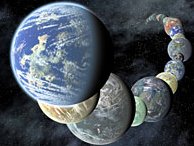
Also exciting is that some astronomers believe there may be hundreds of small rocky planets in the outer edges of our own solar system, and a couple of these objects may even be as big as Earth.
Michael Meyer, an astronomer from the University of Arizona, said he believed Earth-like planets were probably very common around Sun-like stars.
"Our observations suggest that between 20% and 60% of Sun-like stars have evidence for the formation of rocky planets not unlike the processes we think led to planet Earth," he said. "That is very exciting."
Mr Meyer's team used the US space agency's Spitzer space telescope to look at groups of stars with masses similar to the Sun.
They detected discs of cosmic dust around stars in some of the youngest groups surveyed.
The dust is believed to be a by-product of rocky debris colliding and merging to form planets.
Nasa's Kepler mission to search for Earth-sized and smaller planets, due to be launched next year, is expected to reveal more clues about these distant undiscovered worlds.
Some astronomers believe there may be hundreds of small rocky bodies in the outer edges of our own Solar System, and perhaps even a handful of frozen Earth-sized worlds.
Speaking at the AAAS meeting, Nasa's Alan Stern said he thought only the tip of the iceberg had been found in terms of planets within our own Solar System.
More than a thousand objects had already been discovered in the Kuiper belt alone, he said, many rivalling the planet Pluto in size.
"Our old view, that the Solar System had nine planets will be supplanted by a view that there are hundreds if not thousands of planets in our Solar System," he told BBC News.
He said many of these planets would be icy, some would be rocky, and there might even be objects with the same mass as Earth.
"It could be that there are objects of Earth-mass in the Oort cloud (a band of debris surrounding our planetary system) but they would be frozen at these distances," Dr Stern added.